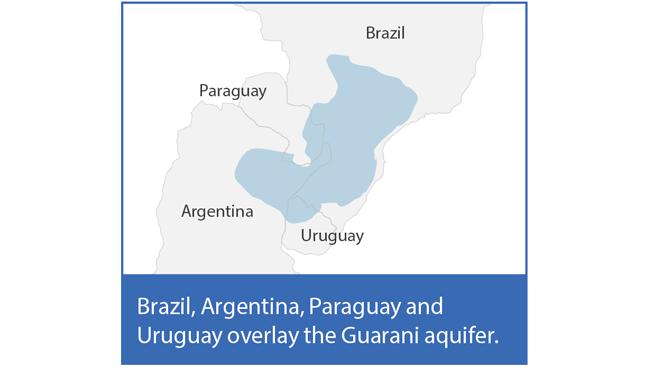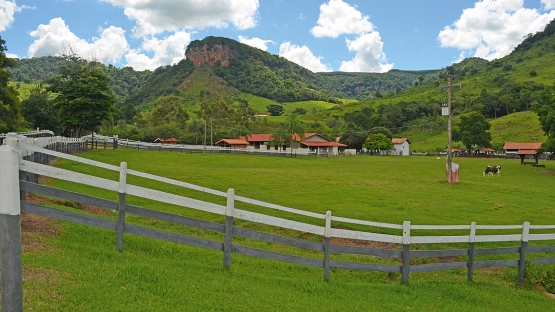Shrouded in mystery, the future of the largest groundwater reservoir in Latin America once left scientists, academics and politicians in Brazil, Argentina, Paraguay and Uruguay concerned about the fate of their major freshwater resource. Uncovering clues using nuclear techniques, Brazil and its neighbours are now well-acquainted with the Guarani Aquifer and can confidently expect that, with their new protection and sustainable use framework, water from the aquifer will continue to flow for at least another 200 years.
Using isotope hydrology, a nuclear technique (see Isotope hydrology), the four countries analysed and assessed the aquifer to evaluate the age, origin and evolution of the groundwater, as well as its quality and the risk of contamination. "The studies were an important contribution to the project because they generated an integrated picture of the whole aquifer, which helped to interpret many important geological, hydrochemical and hydrogeological findings," said Hung Kiang Chang, Professor at the Institute of Geosciences and Exact Sciences (IGCE) at the São Paulo State University.
Hidden under lush green fertile lands, the aquifer spans over 1.2 million square kilometres — three times the size of the Caspian Sea. With stores of over 37 000 cubic kilometres of fresh water in its sandstone pores and fissures dating back to around 200 to 130 million years ago, it is a source of drinking water, and it supplies industry, agricultural irrigation and thermal spa tourism for the region.
"It is an incredible transboundary groundwater resource that has been around for hundreds of thousands of years," said Chang. "The aquifer influences the lives of millions of people. If it were no longer available, the impact would be enormous."
The aquifer is particularly important for Brazil, as the country consumes around 90 per cent of the one billion cubic metres of total water extracted per year, with 14 million people relying on it, Chang added.
The impact of civilization
Though much of the aquifer remains intact, civilization has taken its toll on the water reserve. "Nature has blessed the region with an abundant supply of water, but it is not enough to endlessly indulge all the needs of modern society," said Chang. "Water consumption is rising and the population is expanding, and in some areas, uncontrolled pollution and unregulated water use can pose a threat," he explained. "Climate change will also strongly affect the rainfall and evapotranspiration in the aquifer recharge areas," he noted.
The consequences of overexploitation and pollution compromise local water supplies due to poor sanitary conditions, which, in the medium term, could lead to ecological imbalance from, for example, bacterial growths in wells that are improperly regulated during drilling, said Gerôncio Rocha, who recently retired as the coordinator of the São Paulo State Preparation Unit for the Guarani Aquifer Project.

Until recently, the four countries had lacked the information they needed to know how civilization impacts the aquifer and how to best protect and sustainably use it. Therefore, they jointly developed the Project for Environmental Protection and Sustainable Development of the Guarani Aquifer System, also known as the Guarani Project.
"The main motivation behind the project was of a technical nature," said Rocha. It raises questions about the aquifer's water flows and the amount of renewable water, how pollution or contamination affects it, where the areas of recharge and discharge are, and its age and chemical composition, Rocha said. In addition to discussions about unregulated exploitation of the groundwater, "these and other questions were the basis of the concerns," said Rocha.
With support from several international organizations, including the IAEA, the project was designed to use scientific and technical studies to understand the aquifer and what measures were necessary to protect and sustainably use it. The countries developed policies for the aquifer's protection and sustainable management that also took into account institutional, legal, economic and environmental dimensions.
Dating the water's age
The Guarani Aquifer Project took place from 2003 to 2009, and the resulting Strategic Action Plan was released in 2011. Though the project led to comprehensive databases of information about the aquifer, "there is still more work needed to provide additional information about the aquifer and its hydrological characteristics," said Luis Araguás-Araguás, isotope hydrologist at the IAEA.
There have since been several follow-up projects undertaken by the four countries, among which is an ongoing IAEA follow-up project with Brazil and Argentina to further study the aquifer's age using isotope hydrology. The project has so far revealed that the groundwater in the central portions of the aquifer is up to 800 000 years old.
Historically, water management in the region has primarily focused on surface water, despite the significant role of groundwater sources. "Today, after the project, there is greater public awareness of the actual and potential threats to the aquifer," Rocha said. "The population's perception of the aquifer's importance is essential for its successful management."
The aquifer influences the lives of millions of people. If it were no longer available, the impact would be enormous.



